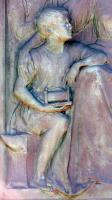

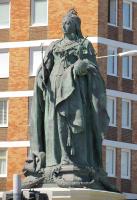
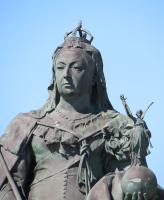
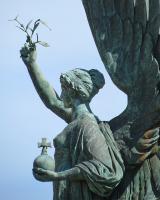
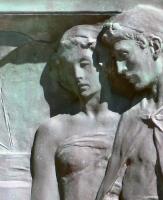
There are a few statues in Brighton, and of these, the two best ones in bronze are both on the beach front: the Edward VII Memorial marking the boundary between Brighton and Hove – it is just inside the former – and a short distance along on the Hove side, at the end of the Grand Avenue, is the Queen Victoria Statue. Together we see portraiture and allegorical figures combined, from an eminent Victorian sculptor and a less well known and somewhat later sculptor mainly of war memorials.
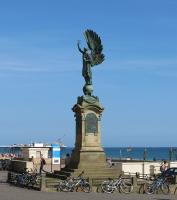 Angel of Peace, Edward VII memorial, Brighton.
Angel of Peace, Edward VII memorial, Brighton.
The Edward VII Memorial, as said, marks the boundary between Brighton and Hove for day-trippers walking along the seafront. The familiar view is the side view of the angel on her high plinth, often as a silhouette because of the bright sun, and to most passers-by, the association with Edward VII is doubtless entirely unknown. The plaque to the king is on the front of the plinth, a pitted and discoloured low relief portrait that seems incidental to the angel.
Newbury Trent's angel, various views. 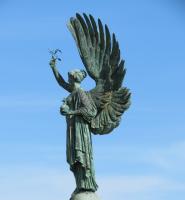
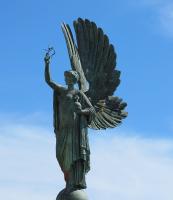
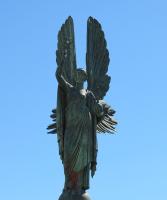
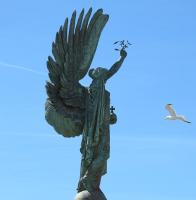
The angel wears Classical drapes, a long dress open at the breast, and a cloak over her arms and back, the one arm sleeved, the other bare but with an arm ring. Her hair is not so long, and piled up and constrained by a band so as to leave her neck exposed. On her brow, a crown of leaves.
The monument is the work of the sculptor Newbury Trent, who signs or imprints his work on the side of the sphere. It is extremely similar to another Angel by the same sculptor at New Barnet in London.
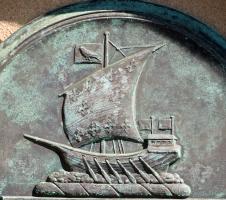
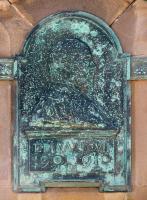 Trireme, and portrait of Edward VII from the base.
Trireme, and portrait of Edward VII from the base.
In the pantheon of statues of Queen Victoria, this one must hold a respectably high place. The great Queen is shown fairly elderly, standing on a tall stone plinth, wrapped in a heavy cloak which gives mass and dignity to the figure. She wears a small crown, and holds in her hands a long sceptre, and an orb on which stands a little winged figure of Victory, holding a trumpet and flaming torch (for more statues of Victory, see this page). Around the base are four fine bronze panels, each with figure sculpture. They are entitled Empire (at the front), Commerce, Science and Art, and Education (at the rear, thus north facing).
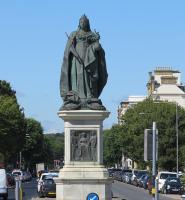 Queen Victoria, Hove, by Thomas Brock.
Queen Victoria, Hove, by Thomas Brock.
Empire has a rather relaxed figure of Justice enthroned in the centre, her scales lying on her lap, and unusually, holding an orb – this is the Justice of Empire (for more statues of Justice, see this page). On the left as we look at it is a Canadian lumberjack with fringed trousers and leaning on an axe, with to the rear an Australian, hands holding his braces and wearing a wide-brimmed hat. On the other side are a tall Indian gentleman wearing a turban, and behind, a vaguely African man, on whose bare chest is a necklace of baubles.
Science and Art has a central seated female again, embracing a boy on our left, who holds a small generator and is seated on an anvil; behind is a further representation of Science in the shape of a youth holding a steam engine regulator. On the other side is Art, with a second youth holding a palette, and in front, a kneeling nude statue of a man, with a sculptor’s hammer and an architect’s compass in front.
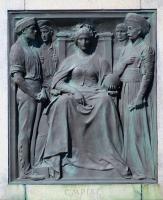
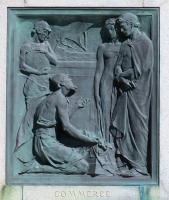 Empire and Commerce panels in high relief.
Empire and Commerce panels in high relief.
Commerce has four figures, the scene being a dialogue between an oriental tradesman kneeling down on the floor, showing his goods to a standing couple – a man in a Classical drape clasped below the throat, and behind, a curvaceous girl in the thinnest of robes. On the other side and further back is a helper of the tradesman, carrying a large pot, and behind the wall behind them all can be seen a ship, with tall prow and single square sail bowed outwards in the trade wind (if you like ship sculpture, see this page).
Finally, Education has the seated female figure turned to one side for variety, holding on her lap a young child to whom she reads; looking on are a pair of scholars, heads bent together over a book, and a dimly seen third man is to the right, drawing with chalk on a board. In front at the base is a globe on a stand. A very nice composition. see this page for more statues of Education.
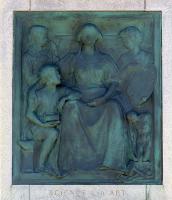
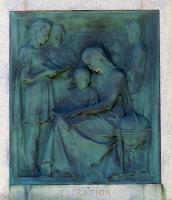 Science and Art, and Education.
Science and Art, and Education.
The statue, commissioned in 1897, was originally intended to commemorate the Jubilee of Queen Victoria, but with her death in 1901 became a memorial to her reign. The sculptor was Thomas Brock, who also made the national Queen Victoria monument outside Buckingham Palace.
The walk from Brighton to Hove along the seafront is very beautiful, either right next to the water with the sound of the waves, or behind the beach, where a line of hotels stretches all the way, some most impressive, like the example at the top of this page.
This page was originally part of a 'sculpture of the month' series, for Sept 2015. Although the older pages in that series have been absorbed within the site, if you would wish to follow the original monthly series, then jump to the next month (Oct 2015) or the previous month (Aug 2015). To continue, go to the bottom of each page where a paragraph like this one allows you to continue to follow the monthly links.
Also in Brighton - Jubilee Clock Tower
Architecture and architectural sculpture // Sculpture in some English towns
Visits to this page from 1 Sept 2015: 11,520